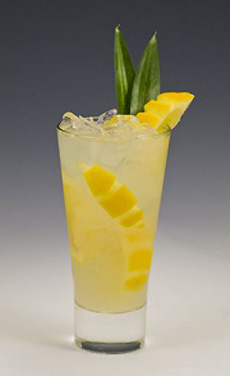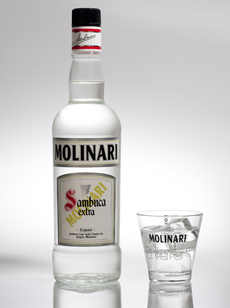COCKTAIL RECIPE: Fizzy Lemonade With Sambuca
|
Each weekend we try a new cocktail recipe. Last weekend it was Fizzy Lemonade, a fresh lemonade made with club soda and sambuca. The recipe was sent to us by Molinari Sambuca Extra. Sambuca (som-BOO-kah) is an anise-flavored liqueur from Italy, one of a family of anise-flavoured alcohol that also includes absinthe (Switzerland), anesone (Italy), anis (Spain), anisette (France) arak (the Levant*), kasra (Libya), mistra and ouzo (Greece), ojen (Spain), pastis (France) and raki (Turkey). The base of sambuca consists of essential oils extracted from the seeds from the star anise (third photo) and other spices; some brands use anise or licorice. The blend also contains elderflowers. The oils are added to pure alcohol and sweetened with sugar. Sambuca is served neat, on the rocks, with water, and with coffee as an after-dinner drink. When drunk after the coffee, it is known in Italy as an ammazzacaffè; added directly to coffee instead of sugar it is called a caffè corretto. The classic serving of sambuca in Italy is a shot topped with seven coffee beans, representing the seven hills of Rome (bottom photo). A shot with just one coffee bean is called con la mosca, “with the fly.” Three coffee beans represent health, happiness and prosperity for some; the Holy Trinity for others. The shot may be ignited to toast the coffee beans; the flame extinguished immediately before drinking. Sambuca shots are delicious year-round; but here’s a refreshing summer samba drink: Ingredients Per Drink 1. MUDDLE the agave and basil in mixing glass. Add the sambuca, a scoop of crushed ice and the lemon juice. Cap and shake vigorously. 2. STRAIN over crushed ice and top with a splash of club soda. Garnish with a lemon wedge and optional cucumber spear or vertical slice. Star anise (Illicium verum) is an evergreen tree native to northeast Vietnam and southwest China. The spice star anise, obtained from the star-shaped pericarp of the fruit, ia also called badiam, Chinese star anise and star anise seed. Each “arm” of the star contains one seed. Star anise closely resembles the herb anise (native to Mediterranean region and Southwest Asia) in flavor, but they are not related botanically. However, both include the chemical compound anethole, which provides the licorice-like flavor. Because star anise is less expensive to produce but provides comparable flavor, it has begun to replace anise in some culinary uses, especially baking. Star anise is a component of Chinese Five Spice powder. The spice blend also includes cinnamon, cloves, fennel seeds and Sichuan pepper, representing all five tastes: sweet, sour, bitter, salty and hot. The proportions vary by producer. |
|
|
|
Star Anise In Cooking It is grown commercially in China, India, and most other countries in Asia. It is used whole to sweeten soups and meat stews. Ground star anise is used as a spice rub; and to flavor breads, custards, pastries, puddings and strudels. Instead of those coffee beans, how about a sambuca shot with a star anise?
|
||






